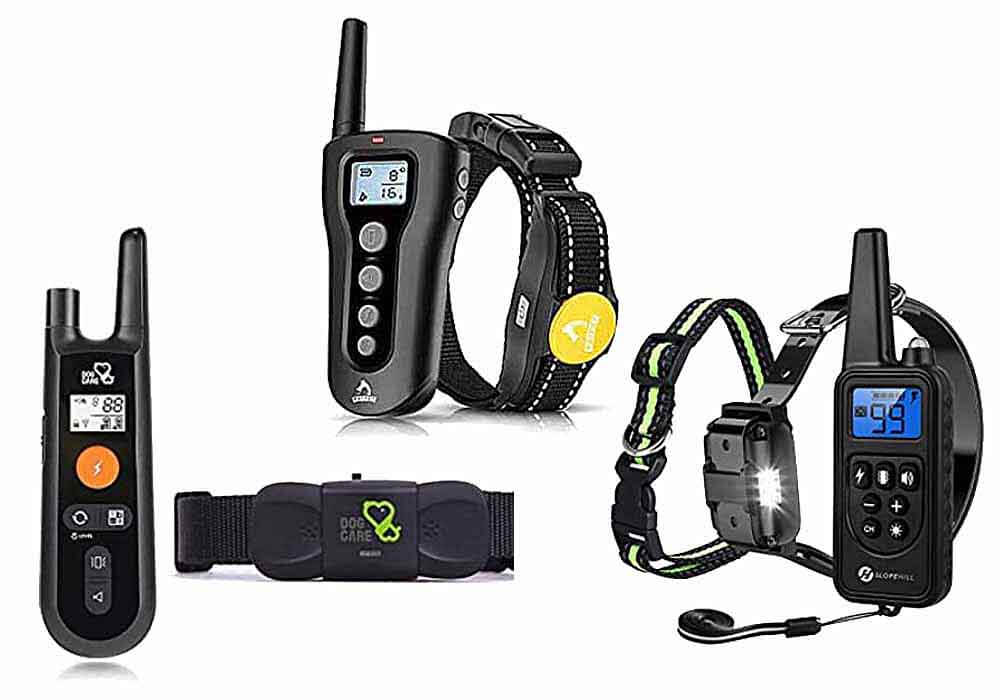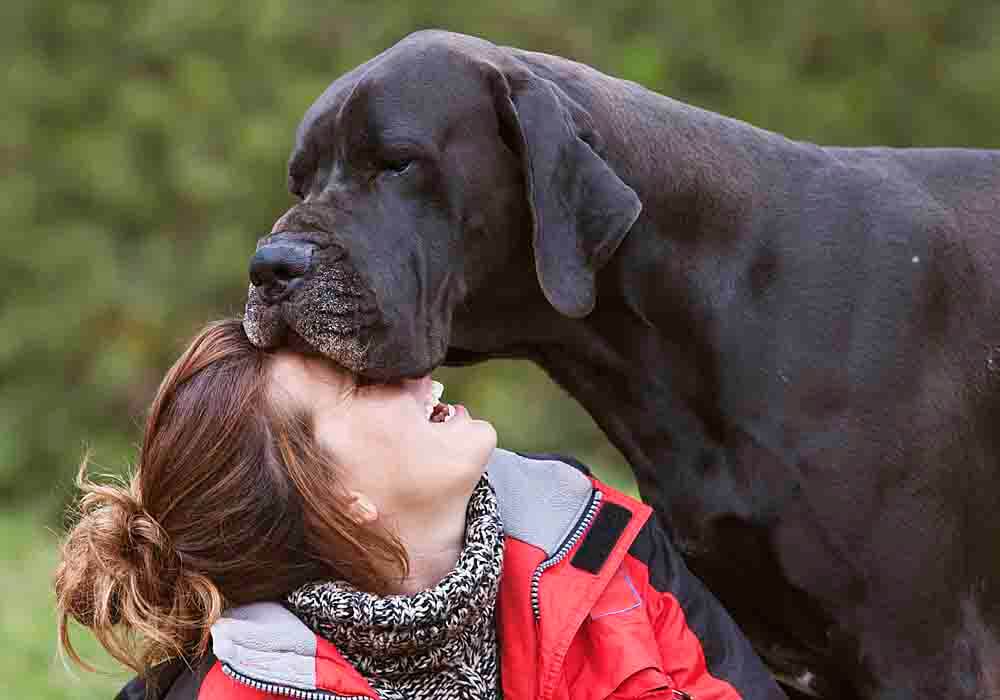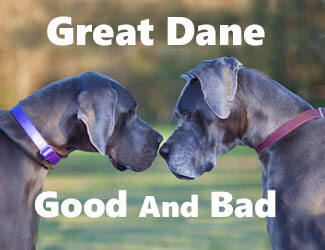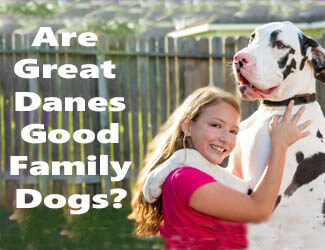How To Stop Great Dane Aggression
Identify The Issues That Cause It
Address Those Issues Thru Training
by Ken Alden
Great Danes are typically an affectionate and playful breed. However, sometimes they can act out and become aggressive depending on the situation they are in or their upbringing.
How To Stop Great Dane Aggression...
- Check for medical conditions first
- Identify the issues that are causing it
- Socialize them properly
- Show confidence when they are afraid
- Train them according to their aggression type
Below we will go over the types of aggression experienced by Great Danes and some tips for overcoming these forms of aggression. Read More Below...
Pro-tip: Ever try lifting a Great Dane? Their weight can hurt not only your back but their joints when they hop down from cars, sofas or even your bed. To protect your back and theirs check out the best Mastiff ramps on Amazon.com now.
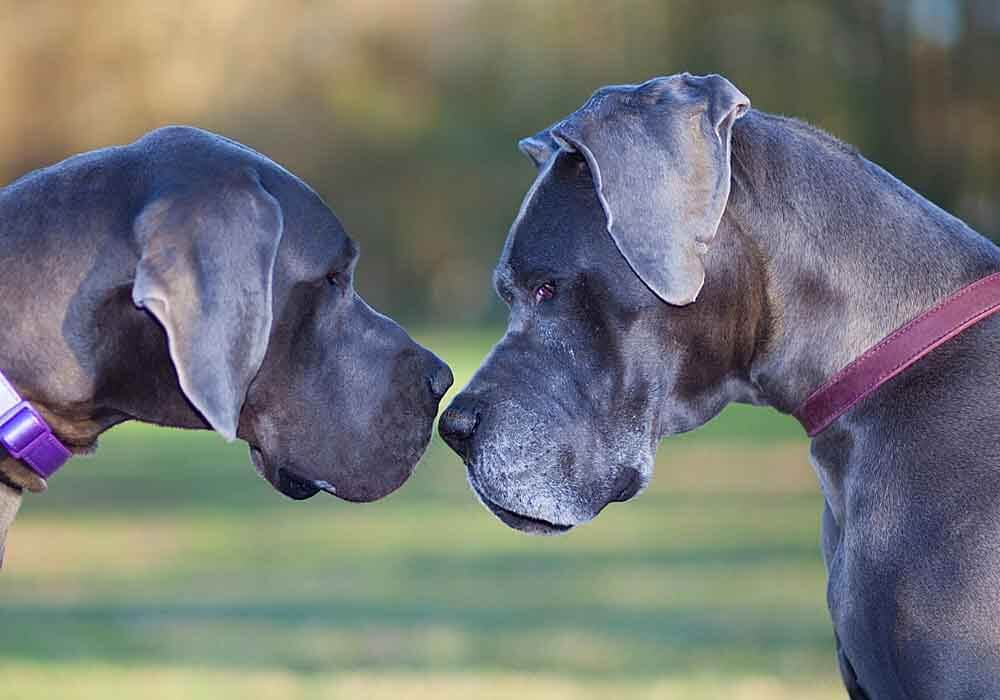
Can Great Danes Be Aggressive?
Great Danes are considered to be affectionate and friendly dogs. They are great with children and loyal towards their owners.
However, Great Danes can be aggressive. This is a problem because of their massive size. A bite from a dog this large can result in some serious injuries.
Great Dane Aggression Issues
Great Danes can become aggressive for several reasons...
- They were not properly socialized
- Lack of proper training
- Introduced to other dogs too quickly
- They become frightened and act aggressively to escape the situation
- Overly protective of their food
- Medical conditions that behavioral changes
Great Dane Puppy Aggression
Great Dane puppies can act aggressively if they aren't
socialized. Socialization is the process of exposing puppies to as many sounds, sights,
smells, textures, people, and animals as possible. how to stop great dane aggression
Great Dane puppies also tend to bite
people during play. While biting starts
out as a non-aggressive act, it can become harmful if the behavior isn't
addressed. Below we will discuss Great Dane socialization and biting behaviors
in detail.
How to Socialize Your Great Dane
Great Dane puppies may act aggressively because they are fearful. Puppies are new to the world, so everything around them is unfamiliar. New things can be frightening, which can make Great Dane puppies feel threatened.
To solve this problem, Great Dane owners need to socialize their
puppies. Properly socializing Great Dane puppies can reduce their aggression
and will make them less fearful in the future. how to stop great dane aggression
When first beginning the socialization process, start with short
15 minute
outings. This prevents
puppies from becoming overstimulated. They should be introduced to a few new
things at a time, and every interaction should be short and sweet.
Listed below are some of the techniques on how to socialize your
Great Dane puppies.
Socialize Them to Touch
Most dogs have areas on their bodies that are sensitive.
Typically puppies don't like it when people touch their face,
ears, paws, or tail. If puppies aren't
properly socialized, they can become aggressive when owners or veterinary
professionals try to touch these areas during grooming or check-ups.
To socialize Great Dane puppies to touch, begin with one area of
their body, such as the ears. Start by gently touching this location. Provide
them with treats and praise every time you touch the sensitive area. Once they
are comfortable with being touched in this location, move onto another spot. Do
this to their entire body until they are comfortable with having every body
part touched.
Expose Them to Aversive Noises
Noises can be frightening for many dogs, especially loud noises. It's best to socialize puppies to a wide variety of sounds and volume levels so that they won't negatively react when they hear those sounds in the future.
One way to socialize Great Danes to new sounds
is by turning on the radio or
the TV. Both of these can expose dogs to numerous
songs, sound effects, and voices, and another way to socialize puppies to
sounds is by walking them down the street. On walks, they'll hear construction
sounds, cars honking, children playing, and more.
Introduce Them to New People
Great Dane puppies should be introduced to people of different ethnicities, heights, and ages. They should also be exposed to people wearing different things, such as hats and sunglasses, and people with other accessories such as canes, wheelchairs, and strollers. how to stop great dane aggression
If possible, Great Dane puppies should also be introduced to children. Children have a lot of energy and act differently than adults, which can scare dogs that were never socialized with them.
Introduce Them to New Dogs
Just like with people, you want to introduce Great Danes to as many kinds of dogs as possible. Make sure they meet dogs of all sizes and ages, as younger dogs act differently than older dogs.
If you have the chance, you should also introduce them to other kinds of animals, such as birds, cats, cows, and horses. The more exposure to new animals, the better.
This article of ours has some additional great ideas for socializing your Dane.
Pro-tip: Great Dane anxiety, aggression, destructive chewing, jumping up, fearfulness, and other behaviors can be controlled with the right training program.
Here’s a great course that
addresses these issues along with many other dog training basics: Check it out now!
How to Stop Great Dane Biting Behaviors
A specific form of aggression often exhibited by Great Dane puppies is biting.
Biting is a natural puppy behavior. Great Danes will bite other puppies during play and will try to do the same to their owners. Great Danes need to be taught from an early age that it is not appropriate to bite people. Otherwise, this behavior could carry over into adulthood.
A Pet Trainer from the pet walking service Wag has come up with a technique to stop Great Danes from biting people, denoted here as "The Yelp Method."
Follow the steps below to try out The Yelp Method.
- Play with the puppies. Start out by simply playing with your Great
Dane puppies. Have some toys available for them to bite. Some recommended toys
include ropes, balls, and chew toys. Continue to play with them as long as they
bite the toys and not your hands.
- Make a yelping sound. Whenever the puppies bite you during play,
make a yelping sound. Puppies naturally yelp when they are hurt to signal to
other dogs that they are playing too rough. Once you make the yelping sound,
they will likely stop biting and look at you.
- Say “Gentle.” After you've finished yelping, look at your
Great Dane puppies and say a command such as "gentle." Repeat this
command whenever applicable. Eventually, your puppies will associate the word
"gentle" with the biting. Your Great Danes will come to realize that
whenever they bite, playtime will be put on pause.
- Reward positive behavior. Always reward the puppies when they are playing appropriately. For example, if they are playing with you and are only biting the toys, provide them with verbal praise and a little treat. However, if they nip you during play, maintain a neutral expression, follow the steps above, and do not provide praise. This will teach them which behaviors you do and do not find acceptable.
More great tips on getting your Mastiff puppy to stop biting can be found on this page of our site.
Great Dane Aggression Towards Other Dogs
Great Dane's are very territorial. Even extremely friendly and social, Great Danes can become hostile if a new pet enters their turf.
If Great Danes aren't introduced to other dogs properly,
aggression may ensue. Follow the tips below to reduce your Great Dane's aggression
towards other dogs.
How to Introduce a New Dog for the First Time
The Pet Poison Helpline has laid out several steps you should take to make your Great Dane's first interaction with a new pet a positive one.
- Pick a neutral location. Since Great Danes are territorial, it is best
if they meet new dogs in neutral
areas, such as parks or sidewalks. Make sure both
dogs are on a leash during the introduction phase so that you'll be able to
move your dog away if something goes awry.
- Walk them together. Take your Great Dane for a walk with the other
dog. Once they are both calm, allow them to sniff each other's bottoms and get
acquainted. Make this initial
introduction short to prevent
either dog from acting aggressively. After the introduction, keep walking
them.
- Be positive. Make sure that you and the other walker are
talking in a relaxed and positive tone. If you yell or act fearfully, the dogs
will be able to sense it, which may provoke aggression. Make the entire
experience as happy as possible.
- Provide them with praise
and treats. Stop them every couple
of minutes for an interaction period. Every time the dogs interact positively,
provide them with a lot of verbal praise. You can also give them treats for
their good behavior. However, do not give them treats while they are
interacting. Great Danes sometimes have food aggression (more about this
below), so they may fight with another dog over the treats.
- Watch their body
language. Pay close attention to
both dogs' non-verbal signals. If either dog becomes very rigid, has a snarl on
their face, shows their teeth, or exhibits any other sign of
aggression, move them apart
immediately. Remember to remain calm. Distract the dogs with other activities
while they are separated. When they are relaxed, reintroduce them for a very
short time. If they don't show any signs of aggression, you can allow them to
spend small amounts of time together every few minutes. How to stop Great Dane aggression
- Return home when they
are calm. If the dogs are acting
calmly and aren't displaying any signs of aggression, they may be ready to go
back to your home. Before you get to the house, walk them around the neighborhood
together to see how they do. If everything goes smoothly, you can bring the new
dog to your home.
How to Introduce a New Dog to the Home
Great Danes need to be acquainted with new pets before they can enter the home. Once your Dane and the new pet have been introduced and are friendly towards each other, follow the steps below. how to stop great dane aggression
- Remove belongings. Before the new dog enters the home, remove all of your Great Dane's possessions, including toys, bones, food, and treats. If you leave a toy on the ground and the new dog plays with it, the Great Dane may act aggressively.
- Enter the yard. Begin by bringing both dogs into your yard, on leashes. If they are acting normal, you can proceed into the house. Always be on the lookout for aggressive body language—showing teeth, wrinkled nose, growling, etc.
- Go inside. Once inside, take the dogs around the inside of the house together. Keep them on their leashes for this. If you are able to go through the house with no mishaps, you can take the dogs off-leash while they are under the supervision and let them spend time together.
- Separate them for the first few weeks. Your Great Dane and new dog are still getting used to each other, so don't rush into things too quickly. Separate them during meals and while they are sleeping. Put them in confined areas where they can't simply leave the room to get the other dog's food. If any food is left in either bowl, pick up the bowl and offer the food to them later to avoid any fights.
- Slowly integrate them together. Reevaluate the situation after a few weeks. If they are getting along, you can slowly start to provide them with more freedom. Begin by letting them spend short amounts of time together without supervision. You can slowly increase this as long as no aggression arises. Eventually, they should be able to spend time together with minimal supervision.
Pro-tip: Great Dane's (and their owners) love dog crates…and for good reasons. Crates keep dogs from mischief while you're away, are perfect for house training, for traveling by car, and provide the dog a place to de-stress. Check out the best Mastiff crates on Amazon.com now.
Great Dane Fear Aggression
Fear aggression occurs when Great Dane's are afraid of something and want it to go away. Typically, dogs prefer to leave the situation, but they'll act aggressively towards the frightening thing if that option isn't available.
When dogs act aggressively because they are afraid, their body language is different. Typically fearful dogs will have a scared posture and will look as though they want to run away.
A lot of fear aggression is removed through socialization. However, dogs can still become afraid even if they were properly socialized. Both puppies and adults exhibit fearful aggression.
To help your Great Dane overcome their fears, check out the
following tips.
Don't Comfort Them
When your pets are afraid, don't try to pet them or comfort them. Comforting a fearful pet is bad for two reasons. The first reason is that they are scared, so they may act aggressively towards you. The second reason is that comforting them will reinforce their behavior and will make it more likely to reoccur in the future.
Remain Calm
Great Danes are able to learn from their owners through imitation. So, if you act scared when they are scared, they will continue to be fearful. However, if you are calm and assertive in these situations, they will learn that they have nothing to be afraid of. Great Danes respond to strong, confident leadership. If you act like a leader and show them they shouldn't be afraid; they'll learn to remain calm in the previously frightening situation.
Great Dane Food Aggression
Many dogs still have an instinctive tendency to protect their food. Great Danes with food aggression may growl, snarl, or bite people who approach them while eating. Some dogs may also act aggressively while eating treats or chewing on bones. In rare cases, dogs may even be protective over their water bowl.
The ASPCA has come up with seven steps to help you get rid of your Great Dane's food aggression.
Follow the steps below to stop Great Danes from being aggressive
around their food. You must do each step for ten meals without aggression
before moving on to the next step.
- Throw a treat from a few feet away. To begin, stand a few feet away from the Great Danes while they are eating. Say something casual like, "what are you eating?" then toss a treat towards their bowl. Repeat these steps every few seconds until they are done eating.
- Throw a treat and move closer. Stand a few feet away from their bowl. Say the same causal phrase, "what are you eating?" Then move one step towards them and throw them a treat. After you've thrown them the treat, move back to your initial position. Every day for ten days, you will continue to move a step closer to your dogs until you are 2 feet (60.7 cm) away.
- Put a treat in the bowl and walk away. Say, "what are you eating?" Then approach them while they are eating, drop the treat into their bowl, and move away. Repeat this step for ten meals. If no aggression is exhibited, move on to the next step.
- Allow them to take the treat from your hand. Say the phrase, "what are you eating?" Then stand next to your dogs, bend down slightly, and encourage them to take the special treat from your hand. After they take it, walk away. Repeat this process until they are done eating.
- Touch the food bowl. Repeat the causal phrase. After you've said it, move towards them. Touch their bowl with one hand while you give them a treat with the other. Repeat this process every few seconds until they are done eating.
- Pick up the food bowl. Start by repeating the phrase. Then, lift their food bowl about 6 inches (15.2 cm) off the ground and put the treat inside. Return the bowl to them and repeat. Each day, you should lift the bowl slightly higher until you are able to hold it while standing upright. By the last day, you should be able to pick up their food bowl, walk over to a counter with it, drop a treat in, and bring it back to them without any aggression.
Older Great Dane Becoming Aggressive
When older Great Danes suddenly becomes aggressive, it may be caused by health problems. Great Danes are prone to certain age-related diseases that can make them feel bad or disoriented and lead to aggression.
Medical conditions such as hip dysplasia, thyroid disorders, and brain tumors can cause aggressive behaviors to arise in older Great Danes.
- Hip dysplasia: Great Danes frequently develop a number of hip and joint problems because of their heavy frames. One of the most common things they suffer from is hip dysplasia. Hip dysplasia is incredibly painful. Some studies have shown that dogs with hip dysplasia are more aggressive than other dogs due to this incredible pain they feel.
- Brain tumors: Brain tumors are basically abnormal groups of cells in the brain. They are commonly seen in older dogs and can cause them to act aggressively depending on where the tumor is situated in the brain.
- Thyroid disease: Great Danes are prone to thyroid disease,
which can cause them to act aggressively. Thyroid disease is easily treatable with medication, but it is
hard to catch without going to the vet.
How To Stop Great Dane Aggression...Final Thoughts
Great Danes' are generally friendly, but they can become aggressive. To stop Great Dane aggression, they should be socialized as puppies to expose them to new things.
They should also be introduced to new dogs slowly, shown confidence by their owners when they are afraid, trained not to be aggressive towards others while they are eating, and taken to the vet frequently so they can check for medical conditions that could cause aggression to arise.

About the Author...
Ken Alden, a dedicated Mastiff owner for over eight years, is acclaimed for his expertise in care, grooming, and training. Read more About Me and my dog Shadow.
- Mastiff Guide Home ›
- Great Danes ›
- How To Stop Great Dane Aggression
